 |
 |
 |
 |
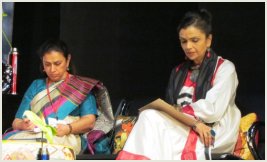
|
 |
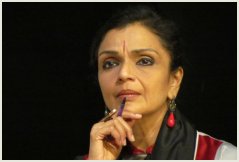 |
|
Conferences  MAD and DIVINE
women, Natya Darshan Seminar
presented by Kartik Fine Arts MAD and DIVINE
women, Natya Darshan Seminar
presented by Kartik Fine ArtsDec 23 - 25, 2011 Chennai Artistes in performance Narthaki Nataraj 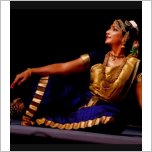 Narthaki
Nataraj is passionately preserving the traditional Tanjore style of
Bharatanatyam. Narthaki’s passion for dance took deep roots when Guru
KP Kittappa Pillai, direct descendant of the Tanjore Quartet, took her
under Gurukulam tradition. She imbibed from her guru without any
embellishments. Narthaki
Nataraj is passionately preserving the traditional Tanjore style of
Bharatanatyam. Narthaki’s passion for dance took deep roots when Guru
KP Kittappa Pillai, direct descendant of the Tanjore Quartet, took her
under Gurukulam tradition. She imbibed from her guru without any
embellishments. ‘Sutta Pazham’ Historians believe that there were at least four Tamil poets named Avvayar at different points in history. The first one belongs to the Sangam period and 59 of her poems are found in Sangam Literature. Later, towards the end of the Bhakti period, the second Avvayar sang the “Vinayagar Agaval” that is considered by Vinayaka devotees as their first book, filled with deep meaning. The third Avvayar sang many poems for children on the subject of right living, such as Aathichoodi, Kondrai Vendhan, Moodurai, Nalvazhi etc. These poems can be memorized in childhood and used throughout one’s life. While the first and second Avvayar lived amidst royalty and devotees respectively, the third Avvayar lived among children. The fourth Avvayar has sung many individual poems and is associated with the story of Lord Murugan asking her, “Do you want a hot fruit or a cold fruit?” In this story, Muruga appears as an ordinary boy who attends to grazing cattle. When Avvayar requests him to help her get some fruit from the ‘Naval’ tree, He asks her whether she needs a hot one or a cold one. She ridicules Him as there is no such thing. To demonstrate His point, He then shakes the tree and the fruits fall on the ground. Avvayar then has to blow the dust off the fruit, upon which Lord Muruga asks her, “Why, Grandma? Is the fruit hot?” Then Avvayar realizes that the boy is really Lord Murugan who teaches her not to be arrogant. Maddhu Nattraj 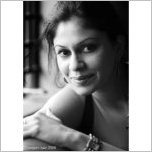 Performer,
choreographer, educator and arts entrepreneur, Maddhu Nattraj studied
Kathak from her mother Dr. Maya Rao and from Guru Chitra Venugopal. A
graduate of commerce, journalism and choreography (Natya Institute of
Kathak and Choreography), she has also trained in Indian martial arts,
ritualistic/folk dance traditions, pedagogy and yoga. Although she
trained in contemporary dance in New York, Maddhu returned to India with
a vision to create a unique dance company (www.stemdancekampni.in) with its own distinctive contemporary Indian dance identity - the Natya STEM Dance Kampni. Performer,
choreographer, educator and arts entrepreneur, Maddhu Nattraj studied
Kathak from her mother Dr. Maya Rao and from Guru Chitra Venugopal. A
graduate of commerce, journalism and choreography (Natya Institute of
Kathak and Choreography), she has also trained in Indian martial arts,
ritualistic/folk dance traditions, pedagogy and yoga. Although she
trained in contemporary dance in New York, Maddhu returned to India with
a vision to create a unique dance company (www.stemdancekampni.in) with its own distinctive contemporary Indian dance identity - the Natya STEM Dance Kampni.Ramya Reddy  After
studying photography at the Light and Life Academy (Ooty), Ramya took
classes at the Santa Fe workshops to explore the direction she wanted to
pursue. Her main focus spans across fine art images, photo art, travel
stories and lifestyle oriented work. Nature is her primary
inspiration, and through her work she hopes to be able to communicate
how necessary it is for us to reconnect with our world and the
environment in simple, heartfelt ways. Currently based out of
Bangalore, she divides her time between artistic pursuits and
commissioned projects. After
studying photography at the Light and Life Academy (Ooty), Ramya took
classes at the Santa Fe workshops to explore the direction she wanted to
pursue. Her main focus spans across fine art images, photo art, travel
stories and lifestyle oriented work. Nature is her primary
inspiration, and through her work she hopes to be able to communicate
how necessary it is for us to reconnect with our world and the
environment in simple, heartfelt ways. Currently based out of
Bangalore, she divides her time between artistic pursuits and
commissioned projects. ‘Nirvaya- Dissolving in divinity’ Nirvaya is inspired and informed by the profound Kannada Vachanas or poetry of the women mystics called Sharanes. Dance and original photo art merge and sometimes move parallel whilst translating the profound concepts of 3 lesser known women mystics - Lingamma, Muktayakka and Molige Mahadevi. The Sharanes belong to the 12th century. Their philosophy is Linga - advaita or monistic Shaivism, with roots in the Vedas and Kashmiri monistic Shaivism. Aikya means salvation. The Sharana salvation is attained by the sight of God and realization of identity with God, followed instantly by disappearing into the great light. “…step by step all distinctions disappear, Knowledge and ignorance disappear, Standing on the tip of the mountain in Shunya, I see a wondrous, shimmering light, I disappear into it,” says Lingamma. The Sharana salvation is ‘Nirvaya’ –‘becoming nothing,’ disappear or vanish without leaving a trace, like camphor on fire. The ‘Linga’ too has a mystic meaning. Li - loss and ‘ga’ – going, disappearance by dissolution. “The end must come before the end, before you mount the last step, climb above the step of you, before you reach God, the step of I must go,” says Molige Mahadevi, reiterating the state of ‘Sajiva mukti’ or salvation when alive. Vachanas, visual art, Kathak and Indian contemporary dance dissolve into each other in experiencing the mysticism of the Sharana women. Credits: Concept: Basrur Subba Rao Choreography: Maddhu Nattraj Photo art: Ramya Reddy Soundscape: Praveen Rao Consultant: Dr. Maya Rao Malavika Sarukkai 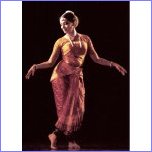 Malavika
Sarukkai is acclaimed globally for her creative dance choreographies,
which transport the viewer to the heartbeat of dance, taking dance
beyond specific geographies. Malavika
Sarukkai is acclaimed globally for her creative dance choreographies,
which transport the viewer to the heartbeat of dance, taking dance
beyond specific geographies. As a passionate path breaking dancer from India, she has contributed a significant and large body of work. Her collaborative productions have synergized through dialogues with artists from different media – poets, musicians, painters, sculptors and contemporary writers. ‘Maname Brindavaname’ Exploring some poems of the Nachiyar Thirumozhi, this dance creation travels from the precincts of the Srirangam temple to the untrammeled spaces of the heart in Brindavan. Through the deeply felt emotions of Andal, we discover passion, longing and the uncontainable desire for Govinda or Thiruvengadam. Her mystical love knows no limits and with surprising honesty she lays bare her vulnerability. The dance choreography highlights the searing and unbridled longing of Andal. Moving from seeing Govinda in the temple to seeing her lord within, nritta and abhinaya coalesce together to effect a sharp body language of emotion and an eloquent dance speak. In her songs of desire she addresses Manmatha, the God of Love, and commands him to aim his flower arrows with the name Govinda inscribed on them to strike at her very heart. Impatiently, she implores the clouds and the birds to be messengers. Yearning deeply, she dreams of her wedding of enchantment as Govinda takes her for his bride. She calls to Govinda drenched in divine infatuation. Andal’s sacred footfalls imprint us as she sings ‘The Nachiyar Thirumozhi’ - The Sacred Song. Together with Andal, we journey through spaces both real and imagined - Srirangam, Brindavan, outer, inner, past, present, touching other realities. Concept and Choreography: Malavika Sarukkai The scholarly research for this production has been provided by Dr. Raghuraman and the evocative music has been composed by Dr. Vanathi. The passionate trans-creations of the poems in English are by poet- novelist Priya Sarukkai Chabria. Sangeeta Isvaran 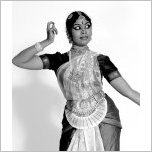 Sangeeta
Isvaran is a choreographer, performer, researcher and social activist
who has performed and taught in over 30 countries. Isvaran, who speaks
over seven languages, has studied dance forms from South Asia, Southeast
Asia, Europe, Latin America and West Africa. She is invited as
visiting professor to conduct seminars and workshops at institutions
around the world. A strong social activist, Isvaran has worked in war
torn, economically underdeveloped countries using dance in education,
empowerment and economic development. She has created programs that use
dance/theatre for conflict resolution with governments in France,
Brazil, Indonesia and India. Sangeeta
Isvaran is a choreographer, performer, researcher and social activist
who has performed and taught in over 30 countries. Isvaran, who speaks
over seven languages, has studied dance forms from South Asia, Southeast
Asia, Europe, Latin America and West Africa. She is invited as
visiting professor to conduct seminars and workshops at institutions
around the world. A strong social activist, Isvaran has worked in war
torn, economically underdeveloped countries using dance in education,
empowerment and economic development. She has created programs that use
dance/theatre for conflict resolution with governments in France,
Brazil, Indonesia and India. ‘Karaikkal Ammaiyar’ “My breasts shrivel, my nerves are stretched to snapping point; my eyes protrude, red and rolling; my stomach caves in and...” It is said that Ammaiyar walked up Mount Kailasa on her head as her feet would defile that sacred ground. However, this upside-down image goes much deeper via her poetry that turns all our ‘pretty’ and ‘romanticized’ notions of enlightenment on their head, releasing a torrent of insane energy spiralling up to explode into fractured, frantic images of both Siva dancing and Ammaiyar dancing, till one cannot be distinguished from the other - if that isn’t moksha, what is? Ammaiyar is a common icon on temple walls, an emaciated figure playing the cymbals as the Lord dances - that was her dearest wish. But the dance that she describes is the dance that destroys illusion to reveal the Ultimate Truth. Her body reflects that destruction, that renunciation of all worldly desires, the burning away of all surplus flesh until what remains is the fiery essence of her love for Siva. Since this experience is difficult to describe coherently in words, her poetry is necessarily disjointed, shocking us with its dissonance yet ringing with the harmony of her truth. Ammaiyar’s powerful poetry hurls images at us, till one can hardly separate illusion from reality, or the devotee from the Lord, transporting us to the state of being called Sivam – where we are ‘Siva’ ourselves. Aditi Mangaldas 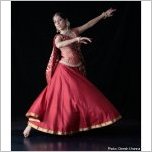 Aditi
Mangaldas is the choreographer and principal dancer of the Aditi
Mangaldas Dance Company – The Drishtikon Dance Foundation, in both the
classical Indian dance form of Kathak and contemporary dance that stems
from Kathak. Aditi has broken new ground by using her knowledge and
experience of Kathak as a springboard to evolve a contemporary dance
vocabulary infused with the spirit of the classical. Her solo
performances and group ensembles, both classical and contemporary, have
received critical acclaim at leading festivals all over the world. Aditi
Mangaldas is the choreographer and principal dancer of the Aditi
Mangaldas Dance Company – The Drishtikon Dance Foundation, in both the
classical Indian dance form of Kathak and contemporary dance that stems
from Kathak. Aditi has broken new ground by using her knowledge and
experience of Kathak as a springboard to evolve a contemporary dance
vocabulary infused with the spirit of the classical. Her solo
performances and group ensembles, both classical and contemporary, have
received critical acclaim at leading festivals all over the world.‘Two solos’ 1. Seeking the Beloved is an extract performed on the poetry of Meerabai. It is from the larger full length production Uncharted Seas. “Oh beloved, my eyes are wonderstruck at your beauty. Your body glows with the jewels that adorn you. Each limb glistens with luster and brilliance! I have become one with you…No wonder people think that I have lost my senses and my way.” Premiered in Delhi in 2006. Vocal composition: Shubha Mudgal and Aneesh Pradhan. Costume: Aditi Mangaldas Light design and execution: Narayan Singh Chauhan 2. Zero Moment: An extract from the larger full length production ‘Timeless.’ Can we hold time past and time future in time present? Premiered in Hong Kong in 2006 Music composition: Shubha Mudgal and Aneesh Pradhan Original light design: Narayan Chauhan Costume: Urvashi Bhargava Dance, concept and choreography for all three solos: Aditi Mangaldas Production: Aditi Mangaldas Dance Company – The Drishtikon Dance Foundation www.aditimangaldasdance.com Mythili Prakash 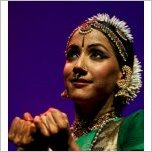 Young, dynamic Mythili Prakash (www.mythiliprakash.com)
is making waves in the field of Bharatanatyam. Trained by her mother
Bharatanatyam exponent Viji Prakash, Mythili has also had the
opportunity to study with several legendary gurus and is currently under
the tutelage of renowned dance exponent Malavika Sarukkai. Mythili has
performed as a soloist for some of the most respected arts institutions
in India. Mythili’s excellence has been acknowledged through her
accolades from some of the premiere institutions of culture in India.
She is also a recipient of numerous coveted fellowships in the United
States, for her choreographic works. Young, dynamic Mythili Prakash (www.mythiliprakash.com)
is making waves in the field of Bharatanatyam. Trained by her mother
Bharatanatyam exponent Viji Prakash, Mythili has also had the
opportunity to study with several legendary gurus and is currently under
the tutelage of renowned dance exponent Malavika Sarukkai. Mythili has
performed as a soloist for some of the most respected arts institutions
in India. Mythili’s excellence has been acknowledged through her
accolades from some of the premiere institutions of culture in India.
She is also a recipient of numerous coveted fellowships in the United
States, for her choreographic works.‘Aikya – in the voice of Akka Mahadevi’ Akka Mahadevi is widely regarded as a social revolutionary in the field of female emancipation and empowerment. Her poetry at once reflects the burning desire that fueled her extraordinary passion and courage: the singular desire of Oneness (Aikya) with her beloved Chennamallikarjuna (Lord as white as Jasmine). This production ‘Aikya’ seeks to reflect the intensity of Akka Mahadevi’s spiritual transformation. Her exceptionally beautiful verses (vachanas) soar the heights of philosophical imagination, yet delve into the infinite depths of the soul with fervent love and surrender. The spark in her heart, which began as childhood adoration for Lord Chennamallikarjuna, was nurtured by the gentle guidance of her childhood guru, who directed her search for the Lord inward. Her awe of existence and wonder at the astounding internal world left her with little interest for the external. She left behind a life of luxury, royalty and material comfort, completely unaffected by societal disapproval of her radical ways. Her close communion with spiritual masters Allama Prabhu and Basavanna was a period of intense transformation. She attainted mahasamadhi in her mid-twenties. Enlightened ones sparkle among us, like stars in the sky. Their outward appearances never reveal the depth of the extraordinary ocean within. Their experiences are inspiration for any seeker. They walk among us as role models, reminding us of our own potential. “Like treasure buried in the ground, like flavor in the fruit, like gold in the rock, and oil in the seed, the Absolute is hidden in your heart.” – Akka Mahadevi Zakir Hussain 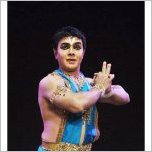 Zakir
Hussain, a research scholar and dancer hails from a traditional Muslim
family in South India. After graduating in fibre technology in his home
town of Salem, he moved to Chennai and fulfill his lifelong dream of
learning from Chitra Visweswaran. Though a Muslim by birth, he
possesses a deep understanding and knowledge of the Vedas, Agamas, and
Indian scriptures, especially of the Vaishnavite tradition. He has done
research on Pancharatra Agama, Vaikanasam and interpreted the
ritualistic mudras into Bharatanatyam. He is an ardent devotee of Lord
Vishnu and Andal. The Department of Vaishnavism at the University of
Madras has acknowledged Zakir as a visiting professor to give lecture on
Vaishnava mythology and history. Zakir
Hussain, a research scholar and dancer hails from a traditional Muslim
family in South India. After graduating in fibre technology in his home
town of Salem, he moved to Chennai and fulfill his lifelong dream of
learning from Chitra Visweswaran. Though a Muslim by birth, he
possesses a deep understanding and knowledge of the Vedas, Agamas, and
Indian scriptures, especially of the Vaishnavite tradition. He has done
research on Pancharatra Agama, Vaikanasam and interpreted the
ritualistic mudras into Bharatanatyam. He is an ardent devotee of Lord
Vishnu and Andal. The Department of Vaishnavism at the University of
Madras has acknowledged Zakir as a visiting professor to give lecture on
Vaishnava mythology and history. ‘Vanamaalai - The garland of love’ Every jeevathma yearns to merge with paramathma, the Supreme - Lord Narayana. Visishtadvaitam speaks about the means of attaining this goal through bhakti (devotion) and saranagatham (self surrender). A devotee should realize his own state as dependent on, supported by, and being led by the Lord, who is the Master. In The Bhagavad Gita, the Lord says that anything offered to Him with utmost devotion and love will be accepted gladly. Accordingly, Periyazhwar, the father and Aandal, the daughter sang hymns in Tamil praising their Lord. Aandal took a step ahead, imagining herself as the wife of the Supreme Lord and finally became one with Him. Vanamaalai deals with two souls attempting in different ways to attain the same destination. Meenakshi Chitharanjan 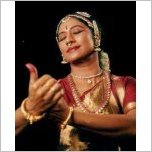 Meenakshi
Chitharanjan learnt Bharatanatyam under Guru Pandanallur Chokkalingam
Pillai and his son Guru Subbaraya Pillai. Her expression of the
Pandanallur style is very much her own, bold, yet feminine, sharp yet
fluid. Meenakshi’s dance academy instituted in 1991 is Kaladiksha.
Her mission, indeed her passion, is to capture the essence of this
ancient style, and while preserving its unique beauty, expand the
repertoire through innovation and experiments. Meenakshi
Chitharanjan learnt Bharatanatyam under Guru Pandanallur Chokkalingam
Pillai and his son Guru Subbaraya Pillai. Her expression of the
Pandanallur style is very much her own, bold, yet feminine, sharp yet
fluid. Meenakshi’s dance academy instituted in 1991 is Kaladiksha.
Her mission, indeed her passion, is to capture the essence of this
ancient style, and while preserving its unique beauty, expand the
repertoire through innovation and experiments. ‘Saint Thirunavakkarasar - The Lord, My Lover’ Saivite Saint Thirunavukkarasar popularly known as Appar has composed poems expressing his profound love for Lord Shiva. To effectively express his all consuming love and bhakti, he has used the vehicle of nayaka – nayika bhava (hero - heroine emotions) to convey his deep yearning. For this symposium on the theme of ‘Mad & Divine’ I chose verses where the nayika (heroine), on seeing the Lord in a grand procession is truly mesmerized by the sight and is filled with a curiosity and urge to know more about him. “Munnam Avanudaya Namam ketal Avanirukkum Vannam ketal Pinnai Avannudaya Aarur ketal Paiyartum Avannikey Pitchi Annal” This translates as: “She heard His name, then she learned of His form, then she heard of His magnificent abode and then she fell madly in love with Him. She left her mother and father, all the proper ways of the world, lost herself, forgot her name and joined the feet of Her Lord, Her Lover. She sang the glory of attaining His feet; she saw Him within herself and danced in this divine Bliss in utter madness. Rama Vaidyanathan 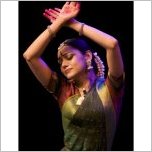 Rama
Vaidyanathan is the foremost disciple of the legendary dancer Yamini
Krishnamurty. She is the Director of Ganesa Natyalaya in Delhi, an
institution founded by her mother-in-law and guru, Saroja Vaidyanathan.
She is a top ranking artiste with the ICCR and has represented India at
several world capitals. While deeply rooted in tradition, she has
evolved her own individual style without forsaking the core principles
of Bharatanatyam. Rama
Vaidyanathan is the foremost disciple of the legendary dancer Yamini
Krishnamurty. She is the Director of Ganesa Natyalaya in Delhi, an
institution founded by her mother-in-law and guru, Saroja Vaidyanathan.
She is a top ranking artiste with the ICCR and has represented India at
several world capitals. While deeply rooted in tradition, she has
evolved her own individual style without forsaking the core principles
of Bharatanatyam. www.ramavaidyanathan.com ‘Soulful Abhangs and Thoughtful Vakhs’ An insight into the life and teachings of the 13th century saint Janabai and the 14th century saint Lalleswari. Both were female mystic poets who went through tremendous hardships before they were finally recognized for their spiritual awakenings. Both were mad and divine and they crossed all barriers of social norms to fearlessly express their love for the supreme. They condemned society for its regressive customs and based their philosophies on love, equality and surrender. Janabai was born in Maharashtra and belonged to the Warkari tradition. Her Marathi abhangs reflect her clarity of thought and her state of spiritual consciousness. Born in a Sudra family, she was a devoted servant maid in the house of the great Saint Namdev. She is supposed to have died the day the saint attained samadhi. Lalleswari's vakhs or sayings in Kashmiri touched the common man for its simplicity yet multi-layered interpretations. She was a staunch Saivite and her vakhs are testimony of her deep love and devotion to the supreme. Lalleswari said, "Siva is omnipresent - Distinguish not between a Hindu and a Mussalman" Janabai said, "Cymbals in hand, a veena upon my shoulder I go about, who can stop me?" ‘Soulful Abhangs and Thoughtful Vakhs’ portray some of Janabai's and Lalleswari's teachings along with some real life incidents which have had a profound effect on their lives. Back to Conferences |